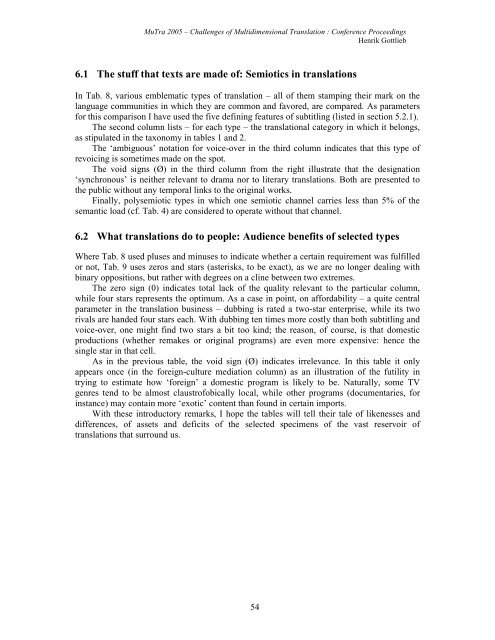Proceedings - Translation Concepts
Proceedings - Translation Concepts
Proceedings - Translation Concepts
You also want an ePaper? Increase the reach of your titles
YUMPU automatically turns print PDFs into web optimized ePapers that Google loves.
MuTra 2005 – Challenges of Multidimensional <strong>Translation</strong> : Conference <strong>Proceedings</strong><br />
Henrik Gottlieb<br />
6.1 The stuff that texts are made of: Semiotics in translations<br />
In Tab. 8, various emblematic types of translation – all of them stamping their mark on the<br />
language communities in which they are common and favored, are compared. As parameters<br />
for this comparison I have used the five defining features of subtitling (listed in section 5.2.1).<br />
The second column lists – for each type – the translational category in which it belongs,<br />
as stipulated in the taxonomy in tables 1 and 2.<br />
The ‘ambiguous’ notation for voice-over in the third column indicates that this type of<br />
revoicing is sometimes made on the spot.<br />
The void signs (Ø) in the third column from the right illustrate that the designation<br />
‘synchronous’ is neither relevant to drama nor to literary translations. Both are presented to<br />
the public without any temporal links to the original works.<br />
Finally, polysemiotic types in which one semiotic channel carries less than 5% of the<br />
semantic load (cf. Tab. 4) are considered to operate without that channel.<br />
6.2 What translations do to people: Audience benefits of selected types<br />
Where Tab. 8 used pluses and minuses to indicate whether a certain requirement was fulfilled<br />
or not, Tab. 9 uses zeros and stars (asterisks, to be exact), as we are no longer dealing with<br />
binary oppositions, but rather with degrees on a cline between two extremes.<br />
The zero sign (0) indicates total lack of the quality relevant to the particular column,<br />
while four stars represents the optimum. As a case in point, on affordability – a quite central<br />
parameter in the translation business – dubbing is rated a two-star enterprise, while its two<br />
rivals are handed four stars each. With dubbing ten times more costly than both subtitling and<br />
voice-over, one might find two stars a bit too kind; the reason, of course, is that domestic<br />
productions (whether remakes or original programs) are even more expensive: hence the<br />
single star in that cell.<br />
As in the previous table, the void sign (Ø) indicates irrelevance. In this table it only<br />
appears once (in the foreign-culture mediation column) as an illustration of the futility in<br />
trying to estimate how ‘foreign’ a domestic program is likely to be. Naturally, some TV<br />
genres tend to be almost claustrofobically local, while other programs (documentaries, for<br />
instance) may contain more ‘exotic’ content than found in certain imports.<br />
With these introductory remarks, I hope the tables will tell their tale of likenesses and<br />
differences, of assets and deficits of the selected specimens of the vast reservoir of<br />
translations that surround us.<br />
54
















